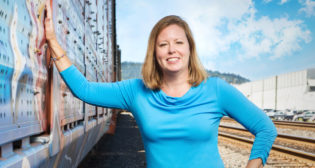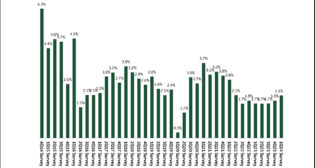
Tank Car of the Future among more Greenbrier railcar contracts
Written by William C. Vantuono, Editor-in-Chief
The tank cars, along with other awards for 4,200 railcars across a full range of railcar types plus those announced in May, bring aggregate awards to 14,700 railcars valued at $1.66 billion. In addition, Greenbrier said there is strong interest from multiple customers in the retrofit of pre-2011-built (pre-CPC-1232) tank cars currently operating in flammable commodity service. “Greenbrier expects that GBW Railcar Services, its recently announced repair, refurbishment, and maintenance joint venture with Watco Companies, will benefit from substantial maintenance and retrofit awards when the joint venture begins operation later this year,” the company said.
The Tank Car of the Future, designated the HM-251, “is designed for safer transportation of crude, ethanol and other flammables in North America as well as use for other hazardous traffic,” Greenbrier said. “The car has advanced safety features that include thicker steel, more robust top and bottom outlet protection, and jacketed shells with ceramic insulation. These new design features combine to inhibit discharge of contents during a derailment, to reduce penetration of the tank shell and to slow pool fires that can result when hazardous contents of a tank car escape in a breach and are ignited. Fire that does not spread as rapidly allows more time for emergency responders to limit the potential damage to communities and the environment that can result after a tank car derailment. The new design will also be equal in capacity volume to the legacy DOT-111 tank car with a loading volume of 30,000 gallons.”
As determined by Conditional Probability of Release (CPR), which measures the likelihood of tank car spills in the event of a derailment at different speeds and by different car types,” the Tank Car of the Future design, at a derailment speed of 50 mph, improves CPR to just over 5% from 45% in bare DOT-111 legacy tank cars,” Greenbrier said. “This improves CPR by more than eight times from the least-protected tank car to the most-protected tank car, the Tank Car of the Future. Also when measured by CPR, the Tank Car of the Future is twice as safe as the current state-of-the-art tank car for transporting hazardous materials—a fully jacketed and insulated CPC-1232. The likelihood of breach in derailment is dramatically reduced by adopting the HM-251 Tank Car of the Future with a 9/16-inch shell and other safety elements, including a 1/8-inch steel jacket and thermal protection and appropriate retrofits to the legacy fleet. This can happen without a loss of payload.”
“Some have suggested that tank cars with a safer design and lower cargo capacity are actually less safe because this results in more total tank cars in service,” Greenbrier said. “That assertion is factually incorrect, because current designs can accommodate 30,000 gallons, a capacity volume equal to legacy DOT-111 tank cars. Moreover, newly designed tank cars perform much better in a derailment.”
Greenbrier estimates the total cost to replace or retrofit aging DOT-111 tank cars, “a design that dates to the 1970s and is unsuited for the high-speed realities of the modern rail operating environment,” will be approximately $3 billion. “A phase-out of the legacy DOT-111 fleet can occur systematically and reach full completion within five years. While the $3 billion investment in a modern tank car fleet for North America is substantial, we believe safety is paramount, and that almost double that value will be generated through job creation and the economic multiplier effect of this investment activity. This economic activity will occur all over America and Canada in almost every state or province as cars are retrofit, retired, and replaced with more modern and stronger designs.”
The proposed HM-251 car is expected to be priced in a range of $150,000-$160,000, Greenbrier noted.
“We are inspired by the commitment to safety demonstrated by our railroad, leasing company, and shipper clients,” said Greenbrier Chairman and CEO William Furman. “Long-awaited regulatory action in Washington D.C. will soon reinforce America’s longstanding priority to protect the public and preserve the natural environment. Current tank car rulemaking must take caution not to squelch or impede the economic miracle associated with the energy renaissance in North America. Development of unconventional energy, including oil and gas from shale formations, has been responsible for up to a 1.5% increase in GDP. This has led to the creation of more than 1.5 million jobs, with steady employment gains. Millions of additional jobs are predicted in the foreseeable future as production of downstream energy products such as plastics and chemicals gains strength throughout America in virtually all states. Meanwhile, manufacturing in America will continue to benefit from lower production costs driven by declining energy prices.”
“Domestic oil and natural gas production is a bridge to a cleaner energy future and a practical way for America to pursue the long-term environmental benefits of clean fuels,” Furman added. “Transportation of oil by rail and barge must be maintained by policy makers as an effective alternative to pipelines if we are to realize the full benefits of our domestic energy windfall. Rail is more fuel efficient and safer than any mode of transport except marine. But, as oil transport by rail has grown, tank car design has not remained current. Crude by rail must continue to play a dominant role in the movement of energy products. This is why Greenbrier and many of its energy, shipper, railroad and leasing company customers are in the vanguard of tank car safety. Greenbrier is investing over $30 million to prepare for the retrofits and new car construction which are imminent.”
“The awards announced today are the first announced in the rail industry for a clearly improved tank car in flammable commodity transportation service,” Furman said. “These commitments demonstrate the willingness of the marketplace to act and respect the need for enhanced safety measures for transporting crude oil and hazardous materials by rail. At the same time, throughout America there will be people performing tank car retrofits and supporting retrofits and new car construction within the supply chain to make tank cars safer at any speed. Many retrofits will be conducted to position oil and ethanol cars in non-flammable hazardous service, something not clearly in focus today, but required to protect lives and the environment. We are proud to be aligned with some of the best customers in the world, who understand the power of serving the public with the primary goal of safety firmly in mind.”
“The U.S. Department of Transportation has been focusing on tank car design improvements and must continue to do so,” Furman said. “North American railroads have been doing the same. DOT should unbundle the rules related to tank car design standards from regulations related to railroad operating requirements. Twice in the past year, railroads have voluntarily imposed speed restrictions for crude oil trains. Pursuing additional railroad operating restrictions prior to issuing new tank car design standards delays the implementation of safer tank car standards and allows risks to communities and the environment related to crude by rail shipments to remain unaddressed. It has been almost four years since the rail industry voluntarily adopted new design standards improving the safety of newly constructed tank cars. Yet, today, the only officially approved design for oil and ethanol cars remains the 1970s designed DOT-111 pre-CPC-1232 tank car.”
“Moreover, blanket railroad operating restrictions will produce unintended consequences throughout the rail network, needlessly imperiling the resurgent North American economy,” Furman concluded. “These consequences could be severe, affecting all industries. The most important action to foster the safer transportation of hazardous materials by rail is to ensure properly classified commodities are shipped in the best designed tank car. The awards for the Tank Car of the Future we are announcing today are a significant milestone in the rail industry’s progress to protect our communities and environment. Greenbrier is proud to contribute to this progress.”



